Related Research Articles

The Baltimore Convention Center is a convention and exhibition hall located in downtown Baltimore, Maryland. The center is a municipal building owned and operated by the City of Baltimore.
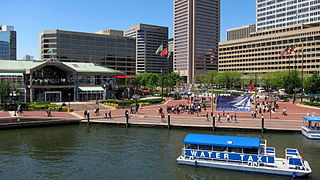
Harborplace is a shopping complex on the Inner Harbor in Baltimore, Maryland.
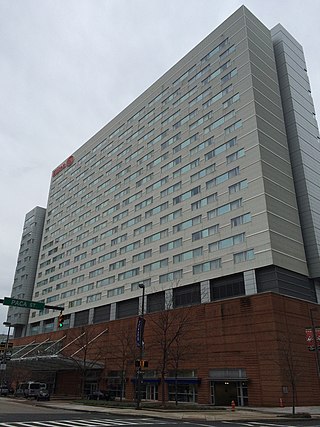
The Hilton Baltimore is a 757–room hotel located on West Pratt Street in Baltimore, Maryland, United States. Initially proposed in 2003, actual construction of the city-owned venture took place between 2006 and 2008 as part of the Baltimore Convention Center. A month before the hotel's scheduled opening in August 2008, Baltimore Mayor Sheila Dixon said that an 18% increase in room night bookings through 2017, as of the fiscal year ending June 30, 2008, compared to the previous year's, confirmed the city's decision to move forward with the hotel development project as a means of bolstering Baltimore's convention business. The massive hotel has been criticized for blocking the once-celebrated views of Baltimore's skyline from the Oriole Park at Camden Yards grandstand, however. The hotel has underperformed projections, losing money in its first three years of operation.
Visit Baltimore, formerly the Baltimore Area Convention & Visitors Association (BACVA), is a quasi-public organization started in 1980 by then-Baltimore Mayor William Donald Schaefer. The agency is charged with bringing in tourists and conventions into the city of Baltimore, Maryland, but does not manage the actual convention venues, hotels, or museums in the city.

The Washington–Baltimore combined metropolitan statistical area is a statistical area including the overlapping metropolitan areas of Washington, D.C. and of Baltimore. The region includes Central Maryland, Northern Virginia, three counties in the Eastern Panhandle of West Virginia, and one county in south-central Pennsylvania. It is the most educated, highest-income, and third-largest combined statistical area in the United States behind New York City–Newark, NJ and Los Angeles–Long Beach.

CFG Bank Arena is a multipurpose arena in Baltimore, Maryland. This venue is located about one block away from the Baltimore Convention Center on the corner of Baltimore Street and Hopkins Place in downtown Baltimore. With a seating capacity of 14,000 for concerts, CFG Bank Arena is owned by the City of Baltimore and managed by the Oak View Group, a global sports and entertainment company.

The Business Development Bank of Canada is a Crown corporation and national development bank wholly owned by the Government of Canada, mandated to help create and develop Canadian businesses through financing, growth and transition capital, venture capital and advisory services, with a focus on small and medium-sized enterprises.

Tax increment financing (TIF) is a public financing method that is used as a subsidy for redevelopment, infrastructure, and other community-improvement projects in many countries, including the United States. The original intent of a TIF program is to stimulate private investment in a blighted area that has been designated to be in need of economic revitalization. Similar or related value capture strategies are used around the world.

Arundel Mills is a shopping mall located in unincorporated Anne Arundel County, Maryland. It is 59.3% owned by Simon Property Group, who manages the mall. With its 1,930,820 sq ft (179,379 m2) GLA, it is the largest mall in the state of Maryland. Developed by The Mills Corporation, the mall is located at the intersection of Maryland Route 100 and the Baltimore-Washington Parkway in northwestern Anne Arundel County. The anchor stores are Cinemark Theatres, Books-A-Million, The Children's Place, TJ Maxx, Burlington, Off Broadway Shoe Warehouse, Sun and Ski Sports, Old Navy, MD Furniture, Bass Pro Shops, Saks Fifth Avenue, Ulta Beauty, Dave & Buster's, Yard House, and Primark.

Power Plant Live! is a collection of bars, restaurants and other businesses in the Inner Harbor section of downtown Baltimore, Maryland. It was developed by The Cordish Companies and opened in phases during 2001, 2002, and 2003. The entertainment complex gets its name from the nearby "Power Plant" building, three blocks south on municipal Pier 4 on East Pratt Street facing the Inner Harbor, which was also later re-developed by Cordish.
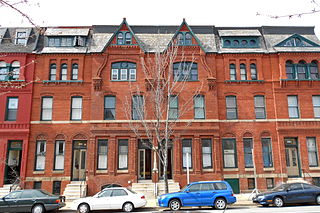
The Station North Arts and Entertainment District is an area and official arts and entertainment district in the U.S. city of Baltimore, Maryland. The neighborhood is marked by a combination of artistically-leaning commercial ventures, such as theaters and museums, as well as formerly abandoned warehouses that have since been converted into loft-style living. It is roughly triangular, bounded on the north by 20th Street, on the east by Greenmount Avenue, and on the south and west by the tracks of Amtrak's Northeast Corridor, though the neighborhood's boundaries include a one-block wide extension over the tracks.
An urban enterprise zone is an area in which policies to encourage economic growth and development are implemented. Urban enterprise zone policies generally offer tax concessions, infrastructure incentives, and reduced regulations to attract investments and private companies into the zones. They are a type of special economic zone where companies can locate free of certain local, state, and federal taxes and restrictions. Urban enterprise zones are intended to encourage development in deprived neighborhoods through tax and regulatory relief to entrepreneurs and investors who launch businesses in the area.

The Inner Harbor is a former industrial quarter of Syracuse, New York, situated at the center of a larger district long colloquially known as Oil City, and since 1989 rebranded as the Lakefront. The waterfront zone was originally considered to be limited to just that area bounded by West Kirkpatrick, Solar, West Bear, and Van Rensselaer streets, but it has been gradually enlarged by the process of familiarity and promotion to include the opposite sides of some of those streets.
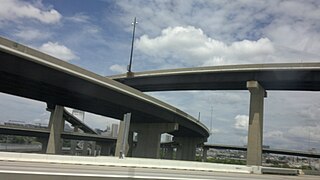
Westport is a neighborhood in south Baltimore, Maryland. Westport is a majority African-American neighborhood that has struggled with crime, housing abandonment, and unemployment in the past decade. The neighborhood is bordered by the Middle Branch of the Patapsco River on the east, the city neighborhoods of Cherry Hill, Brooklyn and the southwestern Baltimore County community of Lansdowne to the southwest, Hollins Ferry Road and the Mount Winans and Lakeland neighborhoods to the west, and Interstate 95 to the north, along with the South Baltimore communities of Federal Hill and Otterbein. The Baltimore–Washington Parkway runs through the middle of Westport and intersects with Interstate 95, the main East Coast super-highway, north to south, Maine to Florida.
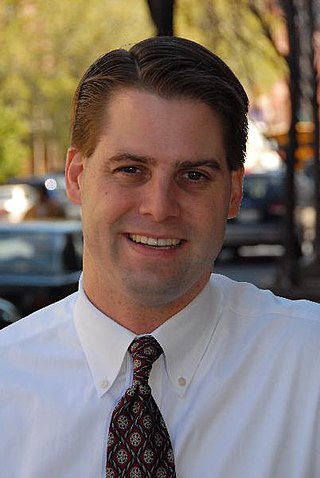
William H. Cole IV is an American politician who represented the 11th District on the Baltimore City Council. He was first elected to a four-year term beginning in December 2007 and served until his appointment by the mayor in August 2014 as CEO and president of the Baltimore Development Corporation.

Port Covington or Baltimore Peninsula is a neighborhood in Baltimore, Maryland.

Baltimore is the most populous city in the U.S. state of Maryland. With a population of 585,708 at the 2020 census, it is the 30th-most populous city in the United States. Baltimore was designated an independent city by the Constitution of Maryland in 1851, and is currently the most populous independent city in the nation. As of the 2020 census, the population of the Baltimore metropolitan area was 2,838,327, the 20th-largest metropolitan area in the country. When combined with the larger Washington metropolitan area, the Washington–Baltimore combined statistical area (CSA) has a 2020 U.S. census population of 9,973,383, the third-largest in the country.
The Maritime Industrial Zoning Overlay District (MIZOD) was created in Baltimore, Maryland in 2004 to preserve deepwater access for port and maritime industrial uses. As waterfront residential and commercial development encroached on maritime industrial uses within the city, waterfront industries were finding it harder to receive loans from banks to upgrade and expand their operations. MIZOD is a zoning district overlaid across existing industrial zones along the water to allow only industries that use or need deep water access. The Overlay district was set to expire in 2014, but was recently extended to expire in 2024.

Marriott Marquis Washington, DC is a luxury hotel located on Massachusetts Avenue NW, in NW, Washington, D.C., United States. The hotel is connected to the Walter E. Washington Convention Center across 9th Street NW via an underground concourse and receives significant business from convention attendees.
David S. Cordish is an American real estate developer, son of Paul L. Cordish, and the third generation CEO and Chairman of The Cordish Companies.
References
- ↑ Langsdale Library (8 February 2012). "Baltimore Industrial Development Corporation (BIDC)". BIDC Collection Overview. University of Baltimore. Archived from the original on 6 July 2012. Retrieved 10 August 2012.
BIDC was governed by a board consisting of seven members of the city government appointed by the Mayor, seven members of the business community named by the Chamber of Commerce of Metropolitan Baltimore, and seven members of the general public selected by the board. The corporation carried out its work under contract with the City, the terms of which provided that it fulfill its duties under the authority and direction of the Mayor. In formulating actions, directions, and policies, former Mayor William Donald Schaefer, (1921-2011), [served 1971-1986], was guided by the city's Economic Development Commission. In 1976, BIDC merged with the Baltimore Economic Development Commission to form the Baltimore Economic Development Corporation (BEDCO). BEDCO later merged with the Howard Street Market Place and Charles Center-Inner Harbor Management, forming the Baltimore Development Corporation in 1991.
- 1 2 3 Tondro, Maximilian (December 2010). The Baltimore Development Corporation: A Case Study of Economic Development Corporations, Shadow Government, and the Fight for Public Transparency and Accountability (PDF) (Thesis). Maryland Legal History Publications. University of Maryland. Retrieved 11 August 2012.
- ↑ "Emerging Technology Center (ETC) Baltimore". Maryland Entrepreneur Hub. Retrieved 2024-04-26.
- ↑ "Initiatives". www.baltimoredevelopment.com. Retrieved 2024-04-26.
- ↑ "Meet BDC". www.baltimoredevelopment.com. Retrieved 2024-04-26.
- 1 2 Kate Davis; Chauna Brocht; Phil Mattera & Greg LeRoy (2002). Subsidizing the Low Road: Economic Development in Baltimore (PDF). Washington, D.C.: Good Jobs First. Archived from the original (PDF) on 10 March 2003.
- ↑ City of Baltimore Development Corporation v. Carmel Realty Associates, et al., 910A.2d406 (Md.3 November 2006)("We hold that the trial court erred as a matter of law and that the City of Baltimore Development Corporation is, in essence, a public body for the purposes of the "Open Meetings Act" and that it is also an instrumentality of the City of Baltimore for the purposes of Maryland's "Public Information Act".").
- ↑ Fritze, John (4 November 2006). "Open Books to Public, BDC is Told; Development Agency has to Disclose Details of Deals". Baltim. Sun . p. 1A. ProQuest 406147382.
In a decision that could have broad implications for the public's right to inspect the workings of government, Maryland's highest court ruled yesterday that the agency overseeing Baltimore's economic development must open its meetings and its paperwork for public review. Writing that the Baltimore Development Corp. has previously been able "to cloak the business of the citizens of the city of Baltimore behind the veil of a supposedly private corporation," the Court of Appeals dismissed city arguments that the agency's closed-door meetings are legal and crucial to the agency's work.
(registration required) - ↑ Gansler, Douglas (October 2011). "Chapter 1: Scope and Agency Responsibilities" (PDF). Maryland Public Information Act Manual (12th ed.). Office of the Attorney General. Archived from the original (PDF) on 2003-03-10. Retrieved 11 August 2012.
- ↑ "Pilots & Tif's". Business Assistance. Baltimore Development Corporation. 2010. Archived from the original on 28 October 2012. Retrieved 9 August 2012.
- ↑ "Tax Credits: Tax Credits Against Local Taxes". Business Assistance. Baltimore Development Corporation. 2010. Archived from the original on 2012-08-07. Retrieved 9 August 2012.
- 1 2 3 "Report of the Task Force on Baltimore City Public/Private Development Financing Efforts" (PDF). Baltimore City Council. October 2011. Archived from the original (PDF) on 2012-07-20. Retrieved 9 August 2012. With: List of TIFs Archived 2012-07-20 at the Wayback Machine , List of PILOTs Archived 2012-07-20 at the Wayback Machine ,
- ↑ Reutter, Mark (9 November 2011). "Subsidies to developers should be prioritized and better monitored, task force says". Baltimore Brew. Retrieved 9 August 2012.
It cited tax breaks at Harbor East, Mondawmin Mall, Belvedere Square, Harbor East and Clipper Mill as examples of "reactive" city policy that used the "but for" rule, meaning that a project would not be built "but for" the use of tax incentives. "The city's current stated TIF and PILOT policies clearly detail the 'but for' test as one of the requirements of approval. However, some in the public perceive that support is not equally available to all projects and developers, and that the financial analysis used to establish the 'but for' is not applied uniformly."
- ↑ "Baltimore City Enterprise Zone". Business Assistance. Baltimore Development Corporation. 2010. Archived from the original on 2012-07-28. Retrieved 9 August 2012.
A business is eligible for the Enterprise Zone (EZ) tax credit program if it makes a capital investment in its property (constructs, renovates, or expands an existing facility) or hires at least one new employee in the Enterprise Zone. Commercial, Retail, and Industrial projects are eligible. Residential properties are not eligible for any of the Enterprise Zone tax credits. If a property is mixed use, the commercial parcels are eligible. The Enterprise Zone also has sections called Focus Areas that offer increase benefits to companies.
- ↑ Baltimore Development Officials Proposing 100% Financing for 750-room Hilton Adjacent to Baltimore Convention Center; Would Issue $290 million in Tax-exempt Revenue Bonds
- 1 2 Logan, John (March 2012). "inside the Baltimore Development Corporation". E-Newsletter. Baltimore Development Corporation. Archived from the original on 2013-01-17. Retrieved 9 August 2012.
- ↑ Ray Weiss; Jessica Trzyna (19 December 2011). "Baltimore's Emerging Technology Center (ETC) Unveils Accelerate Baltimore". Baltimore Development Corporation.
Noting that Accelerate Baltimore will require participating companies to remain in Baltimore for at least five years, Baltimore Mayor Stephanie Rawlings-Blake adds, "By capitalizing on the City's strengths, these companies will not only succeed in their own right, but will become a magnet to draw other technology companies to the City while simultaneously providing jobs and expanding the City's tax base." Mayor Rawlings-Blake has been a strong supporter of the ETC and increased its funding in the most recent budget.
- ↑ Logan, John (20 June 2012). "Cordish Company Submits Revised Proposal for 701 E. Baltimore Street". Baltimore Development Corporation. Archived from the original on 2012-07-26. Retrieved 9 August 2012.
The Cordish Companies' revised proposal calls for a mixed-use development consisting of 226 rental apartments, 15,000 square feet of retail space and 225 above grade parking spaces. Project costs have been estimated at $63 million. A request for City financial assistance in the form of a PILOT (Payment In Lieu of Taxes) is part of the proposal.
- ↑ "BDC Receives Two Proposals For New Inner Harbor Attraction". Baltimore Development Corporation. 1 June 2012. Archived from the original on 2012-11-01. Retrieved 9 August 2012.
The Baltimore Development Corporation (BDC) announced today that it has received two proposals in response to the Request for Proposals (RFP) issued by BDC and the Baltimore City Department of Recreation and Parks, on behalf of the City of Baltimore, for a New Inner Harbor Attraction to be located between the Maryland Science Center and Rash Field.
- ↑ "BDC to Hold Public Hearing for Proposed Changes to Baltimore's Enterprise Zone". Baltimore Development Corporation. 23 March 2012. Archived from the original on 2012-04-23. Retrieved 9 August 2012.
The Enterprise Zone is a property tax credit program for businesses making capital investments in their property (i.e., construction or renovation of a building, or expansion of an existing facility) or hiring at least one new employee in the Zone. Commercial and retail as well as industrial projects are eligible. Residential properties are not eligible for any of the Enterprise Zone tax credits.
- ↑ Briggs, James (31 July 2012). "Harbor Point developers seek enterprise zone status". Baltimore Business Journal. Retrieved 9 August 2012.
The owners of Harbor Point and the Alameda Marketplace are seeking changes to Baltimore City's enterprise zone that could lead to millions of dollars in tax breaks.
- ↑ "Enterprise Zone Expansion Applicants (Aug 8 Public Hearing)". Baltimore Development Corporation. 23 July 2012. Archived from the original on 2012-08-11. Retrieved 9 August 2012.
The Baltimore Development Corporation has received an application submitted by Harbor Point and surrounding properties to be included in the Enterprise Zone for this fall's expansion.
- ↑ "City-sponsored redevelopment corporation ruled to be a "public body"". Archived from the original on 2007-10-22. Retrieved 2008-04-21.
- ↑ http://www.courts.state.md.us/opinions/coa/2006/14a06.pdf Maryland Court of Appeals Ruling